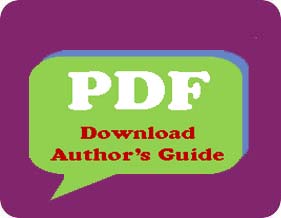Please use the following rules for whole text, including abstract, keywords, heading and references.
Abstract
A concise and factual abstract is required (maximum length of 150 words). The abstract should state briefly the purpose of the research, the principal results and major conclusions. An abstract is often presented separate from the article, so it must be able to stand alone. References should therefore be avoided, but if essential, they must be cited in full, without reference to the reference list.
Keywords
Immediately after the abstract, provide 5-8 keywords, avoiding general and plural terms and multiple concepts (avoid, for example, 'and', 'of'). Be sparing with abbreviations: only abbreviations firmly established in the field may be eligible.
Subdivision of the article
Divide your article into clearly defined and numbered sections. Subsections should be numbered 1., 2., (then 1.1, 1.1.1, 1.1.2), 1.2, etc. (the abstract is not included in section numbering). Use this numbering also for internal cross-referencing: do not just refer to 'the text.' Any subsection, ideally, should not be more than 600 words. Authors are urged to write as concisely as possible, but not at the expense of clarity.
Figure and schemes
Present these at the appropriate points within the text. They are described in more detail below. Number figures consecutively in accordance with their appearance in the text. Place description to Figures below the figure body and group them together. High-resolution graphics files must always be provided additionally separate from the main text file.
Tables
Present tables at the appropriate points within the text. Number tables consecutively in accordance with their appearance in the text. Place description to tables below the table body in an additional row of the table. Avoid vertical rules. Be sparing in the use of tables and ensure that the data presented in tables do not duplicate results described elsewhere in the article.
Formula
The text size of formula should be similar with normal text size.
References
Responsibility for the accuracy of bibliographic citations lies entirely with the authors.
Citations in the text
Please ensure that every reference cited in the text is also present in the reference list (and vice versa). Avoid citation in the abstract. Unpublished results and personal communications should not be in the reference list, but may be mentioned in the text. Citation of a reference as 'in press' implies that the item has been accepted for publication.
Citing and listing of web references
As a minimum, the full URL should be given. Any further information, if known (author names, dates, reference to a source publication, etc.), should also be given. Web references can be listed separately (e.g., after the reference list) under a different heading if desired, or can be included in the reference list.
Text
Citations in the text should follow the referencing style used by the American Psychological Association. You can refer to the Publication Manual of the American Psychological Association, Fifth Edition, ISBN 1-55798-790-4, copies of which may be ordered from
http://www.apa.org/books/4200061.html or
APA Order Dept., P.O.B. 2710, Hyattsville, MD 20784, USA or APA, 3 Henrietta Street, London, WC3E 8LU, UK.
List: References should be arranged first alphabetically and then further sorted chronologically if necessary. More than one reference from the same author(s) in the same year must be identified by the letters "a", "b", "c", etc., placed after the year of publication.
Examples:
Reference to a journal publication:
Van der Geer, J., Hanraads, J. A. J., & Lupton R. A. (2000). The art of writing a scientific article. Journal of Scientific Communications, 163, 51-59.
Reference to a book:
Strunk, W., Jr., & White, E. B. (1979). The elements of style. (3rd ed.). New York: Macmillan, (Chapter 4).
Reference to a chapter in an edited book:
Mettam, G. R., & Adams, L. B. (1994). How to prepare an electronic version of your article. In B. S. Jones, & R. Z. Smith (Eds.), Introduction to the electronic age (pp. 281-304). New York: E-Publishing Inc.
Reference to a web source:
Smith, Joe, (1999), One of Volvo's core values. [Online] Available: http://www.volvo.com/environment/index.htm (July 7, 1999)


